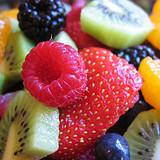Quince Fruit Nutrition Facts,
Health Benefits of Quinces
All about quince fruit nutrition information, quince nutritional benefits, calories in a quince, quince nutrients
A ripe quince has a lovely yellow skin and looks like an overweight pear. It originates from Asia and has been dated back more than 2,000 years.
A quince cannot be eaten raw as it is astringent. In other words it will leave your mouth very dry, just like an unripe banana. It’s low in calories, just 57 calories per serving (100g or 3.5oz) and provides a good source of vitamin C. It’s also full of pectin which is believed to help lower cholesterol, regulate blood sugar and prevents the total absorption of fat as it creates a gel in the stomach.
As it has a high pectin content, the quince is ideal for jams and jellies. Just like a pear, the core of this fruit needs to be removed. Try experimenting with it, stewing or baking the fruit, mix in apples and pears. When purchasing, select ones that have a smooth skin. They are a hard fruit so expect them to be firm. Kept refrigerated, they should last for at least a month.
Compare quince fruit nutrition facts to the other fruits.

Nutritional Value of Quinces
| Quince fruit nutritional value per 100 g (3.5 oz) Refuse: 39% (Core, seeds, and parings) Scientific Name: Cydonia oblonga |
|
|---|---|
| Proximates: | |
| Water | 83.80 g |
| Energy | 238 kJ (57 kcal) |
| Protein | 0.40 g |
| Carbohydrates | 15.30 g |
| Total Fat: | 0.10 g |
| Fiber | 1.9 g |
| Cholesterol | 0 mg |
| Minerals: | |
| Calcium, Ca | 11 mg (1 %) |
| Iron, Fe | 0.70 mg (4 %) |
| Magnesium, Mg | 8 mg (2 %) |
| Phosphorus, P | 17 mg (2 %) |
| Potassium, K | 197 mg (4 %) |
| Sodium, Na | 4 mg (0.2 %) |
| Zinc, Zn | 0.04 mg (0.3 %) |
| Copper, Cu | 0.130 mg (7 %) |
| Selenium, Se | 0.6 mcg (1 %) |
| Vitamins: | |
| Vitamin C | 15.0 mg (25 %) |
| Thiamine (Vit. B1) | 0.020 mg (1.3 %) |
| Riboflavin (Vit. B2) | 0.030 mg (2 %) |
| Niacin (Vit. B3) | 0.200 mg (1 %) |
| Pantothenic acid (B5) | 0.081 mg (1 %) |
| Vitamin B6 | 0.040 mg (2 %) |
| Folate (Vit. B9) | 3 mcg (1 %) |
| Vitamin A | 40 IU (1 %) |
| Percentages are relative to US Recommended Daily Intake (RDI) for adults. | |
Author: Lana Soko
You Might Also Like:
Like This Page?
|
Share This Page:
|






